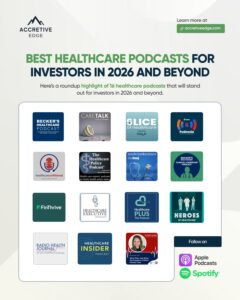TL;DR — Your Investor Pitch Checklist
Avoid these 15 mistakes to keep from giving investors an easy reason to say no:
- Taking too long to reveal your solution.
- Skipping a compelling patient story.
- Pitching without clinical validation or pilot results.
- Offering vague revenue and reimbursement plans.
- Lacking a clear regulatory and compliance pathway.
- Targeting misaligned or inexperienced investors.
- Pitching at the wrong time — too early or too late.
- Relying solely on cold outreach.
- Using generic or meaningless competitor slides.
- Failing to stand out in saturated market categories.
- Overlooking cybersecurity requirements.
- Ignoring engagement and utilization metrics.
- Overloading the pitch deck with excessive detail.
- Requesting NDAs before initial discussions.
- Hiding vulnerabilities instead of addressing them openly.
Raising capital in digital health is already an uphill climb. The stakes are high, and you have minutes to make your case. Blow those first slides, and you’ve lost the room — sometimes for good. Many founders do exactly that, walking in with a pitch that’s either so generic it could be for any startup, or so incomplete it skips over what healthcare investors actually need to hear.
Either way, you hand them a reason to pass.
In this piece, we’ll break down the most common mistakes founders make when pitching digital health investors, why they matter, and what it takes to make your deck feel credible, relevant, and built for this market.
1. Taking Too Long to Get to Your Solution
Some founders burn through half their pitch just setting up the problem. They fill slide after slide with statistics, industry reports, and competitor shortcomings — only to leave investors wondering when they’ll actually see the product.
In digital health, that’s a fast way to lose the room. Most healthcare investors already know the pain points. They’ve seen them firsthand in their portfolio companies, advisory work, or their own operating careers. As Paul Grand, CEO of MedTech Innovator notes: “Investors either inherently know or have plenty of time after your pitch to dig into the status quo. Get to your solution quickly. Don’t make us wait.”
When you linger too long on the setup, you risk two things:
- Investors mentally drifting before you’ve made your case
- Accidentally making competing solutions sound more attractive than yours
Summarize the problem in one or two well-chosen slides — ideally with a human story that brings it to life — and give yourself more time to walk through the mechanism, proof points, and business case for your product. That’s what earns you a second meeting.
2. Skipping the Patient Story
Paul also puts it bluntly: “Your story is almost always a story about patients… We want to see and feel the human cost of the problem.”
Many digital health decks talk about the problem in abstract terms. They show close-ups of body parts, workflow diagrams, or screenshots of the product, but never an actual patient. The result? Investors can’t feel the human cost of the problem you’re solving.
Healthcare is a human business. A well-chosen patient story creates instant context for why your solution matters, and it makes the stakes tangible.
When you leave the patient out of the story, you’re asking investors to connect the dots themselves. That’s a risky bet. Instead, anchor your pitch in a real patient journey — starting with one individual’s experience, then showing how that problem scales across a population. And make it inclusive. Not all patients are white, not all doctors are men, and not all nurses are women.
Without this, your pitch may be technically sound, but it won’t resonate. With it, you’re more likely to earn both attention and trust.
3. Pitching Without Clinical Validation
A promising algorithm or elegant interface isn’t enough to win over a healthcare investor. In this market, evidence is the currency. Investors want to see that your solution works in the real world — through clinical trials, peer-reviewed studies, or at least credible pilot results.
Lynne Chou O’Keefe, founder and managing partner at Define Ventures, warns that too many decks give the clinical model only a token mention, even when it’s the foundation for achieving what she calls the “triple aim” of better population health, improved care experience, and lower costs. If you can’t show how your product delivers on those goals, it’s a red flag.
Even small-scale pilots with hospitals, payers, or pharma partners can signal traction. In regulated markets, early validation is often the deciding factor between interest and a pass. Skipping it means asking investors to take your word for it, and most won’t.
4. Vague Revenue and Payment Strategy
A lot of promising digital health products die in the gap between approval and adoption. They clear regulatory hurdles, launch with fanfare — and then sit unused because no one has a budget line or reimbursement pathway for them.
As angel investors Halle Tecco and Nikhil Krishnan put it, “If physicians cannot bill for it they won’t use it, and they definitely won’t be paying you.” The same principle applies across healthcare: if the payment mechanics aren’t built in, adoption stalls.
That means your pitch needs more than a broad “we’ll sell to hospitals” statement. It needs clarity:
- Who actually pays (hospital department, payer, employer, pharma partner)
- How they pay (budget line, CPT code, bundled payment)
- Why they’ll keep paying (financial return, regulatory requirement, competitive advantage)
If you can’t explain this in your deck, you leave investors guessing, and guessing rarely ends in a term sheet.
5. No Regulatory or Compliance Plan
Even the most innovative digital health product may stall without a clear path through regulatory and compliance requirements. Investors know this, which is why a missing or vague regulatory plan can sink a pitch.
Healthcare moves at the speed of regulation. That means understanding — and showing you understand — what’s required for your product to get adopted. For some, that’s FDA clearance. For others, it’s HIPAA compliance, CE marking, or MDR requirements. Skipping this in your pitch signals that you haven’t thought through a critical gate to market.
A credible regulatory plan doesn’t have to be pages long. It just needs to show that you know the landscape, have the right expertise guiding you, and have integrated compliance into your roadmap. Without it, investors see unnecessary risk — and risk without a plan is a reason to pass.
6. Misaligned Investor Fit
Not all capital is the right capital. Many founders spend months pitching to investors who don’t back healthcare or regulated AI, or they take money from firms that push for timelines and exits that don’t match the realities of selling into health systems.
The result is wasted time at best — and at worst, a strained board relationship that pulls you off course. Healthcare fundraising is about fit as much as it is about funding. Investors with relevant portfolio companies, networks inside health systems, and experience in regulated markets will understand your sales cycle and adoption hurdles.
If your pitch isn’t aimed at the right audience, you’re already fighting uphill. Alignment here means you’re not just looking for a check, you’re looking for a partner who can help you navigate a complex, slow-moving market.
7. Pitching Too Early or Too Late
Timing can make or break your raise. Pitch too early, and you’re asking investors to buy into an idea without enough traction to prove it can work. Pitch too late, and you’re running out of cash — which shifts the conversation from growth to survival.
Both situations put you in a weak position. Investors in digital health expect to see enough progress to de-risk the concept, but they also want to feel you have the runway to execute after the raise. That’s why the best fundraising processes start months before you actually need the money.
Building relationships early means you’re not introducing yourself for the first time during a live raise. It gives investors a chance to follow your progress, see milestones, and step in when the timing is right for both sides.
8. Relying Only on Cold Outreach
In early-stage digital health, warm introductions matter. Investors are far more likely to take a meeting — and take you seriously — when the intro comes from someone they trust. That could be a current portfolio founder, a healthcare operator, or a fellow investor already in your round.
Cold outreach isn’t automatically bad, but if it’s your only approach, your odds drop sharply. Even a cold email needs to be highly personalized and relevant to the investor’s focus area. What doesn’t work? Generic pitch blasts or paying an intermediary to “shop” your deal.
A warm intro tells the investor someone credible has already vetted you. In a market as relationship-driven as healthcare, that signal can be the difference between getting a meeting next week and sitting in the inbox forever.
9. Generic Competitor Slides
The classic two-axis chart with your company in the top-right corner might look clever, but it rarely tells investors anything meaningful. In fact, it can raise more questions than it answers. If your positioning looks arbitrary, they may assume your differentiation is too.
Healthcare investors want to understand how you truly stand apart — not just visually on a chart, but in capabilities, outcomes, or business model. A feature-by-feature comparison can work if it’s honest and highlights real advantages. Even better is a short, concrete narrative that explains why your approach wins in a crowded space.
If you use a chart at all, keep the details in the appendix for deeper discussion. The main pitch should make your competitive edge obvious without needing a graph to prop it up.
10. Failing to Stand Out in Crowded Spaces
Some digital health categories are overflowing with solutions — think mental health apps, clinical documentation tools, or remote monitoring platforms. If your pitch doesn’t clearly explain what makes you different, investors will assume you’re another version of what they’ve already seen.
Saying you have “better outcomes” or a “more intuitive interface” isn’t enough. Investors want a sharp, specific reason why your approach wins. That could be a unique clinical pathway, a business model advantage, or an integration capability competitors can’t match.
When you can’t articulate this clearly, you disappear into the noise. When you can, you give investors a reason to believe you’re not just entering the market — you’re positioned to lead it.
11. Overlooking Cybersecurity
In healthcare, weak security isn’t just a technical flaw — it’s a deal breaker. Health systems are constant targets for cyberattacks, and any new technology they adopt must meet strict security and data protection standards.
If your pitch barely mentions cybersecurity, investors will assume it’s not a priority. That’s a fast way to lose both capital and customer interest. At minimum, you need to show that data safety is built into your product from the ground up — not tacked on later.
Clear security measures, compliance certifications, and a plan for ongoing risk management help investors see that you can be trusted. Without them, your solution may not even make it past the first round of diligence with a health system.
12. Ignoring Engagement and Utilization Metrics
A signed contract is only the beginning. In healthcare, products that aren’t used regularly by clinicians or patients quickly lose their foothold — and health systems won’t renew what they don’t see in action.
Investors know this, which is why they look beyond sales numbers to see if the solution is actually being adopted. Metrics like monthly active users, average session time, or percentage of eligible patients enrolled can speak volumes about real-world traction.
If your pitch can’t show sustained usage, it raises questions about stickiness and long-term revenue potential. If it can, you signal that your product doesn’t just get in the door — it stays there.
13. Overloading The Deck
Founders often try to pack everything into their pitch — every feature, data point, and customer quote. The result is a dense, exhausting deck that leaves little time for conversation.
In investor meetings, less really can be more. A focused, high-impact story gives you room to answer questions and adapt to the discussion. Paul Grand recommends keeping the formal pitch to about a quarter of the meeting time and saving deeper detail for backup slides.
If your deck runs past 15 core slides or forces you to rush to finish, you’re probably doing too much. Investors don’t need the full manual — they need a clear, compelling reason to keep talking.
14. Requesting NDAs Up Front
Asking investors to sign an NDA before you share your pitch is a fast way to slow down — or stop — the conversation. Most professional investors won’t do it, and in digital health, it can signal inexperience or an inflated sense of secrecy.
Healthcare investors see dozens of pitches in your category each year. An NDA can limit their ability to talk with other companies or evaluate the market fairly, which is why they avoid them. If your value proposition can’t be shared openly, the bigger issue might be that it’s not truly defensible.
Instead of paperwork, focus on telling enough of your story to spark interest while keeping truly sensitive details in reserve until due diligence.
15. Hiding Vulnerabilities
Some founders try to present their company as flawless — a complete team, no execution risks, no unanswered questions. In reality, experienced investors know every early-stage company has gaps. Pretending you don’t can come off as naïve or evasive.
Being transparent about challenges — whether it’s missing a key hire, needing additional regulatory expertise, or still testing certain features — shows self-awareness. It also opens the door for investors to offer help, connections, and resources.
In a market as complex as healthcare, vulnerability isn’t weakness. It’s a sign you understand the road ahead and are realistic about what it will take to get there.
Avoiding the mistakes in this list won’t guarantee a term sheet, but it will keep you from handing investors an easy reason to say no. A credible pitch in healthcare connects clinical value, financial return, and operational fit — and shows you can deliver all three.
If you want help sharpening your positioning, telling your story in a way that resonates with healthcare investors, and designing sales enablement content that actually moves deals forward, let’s talk.






